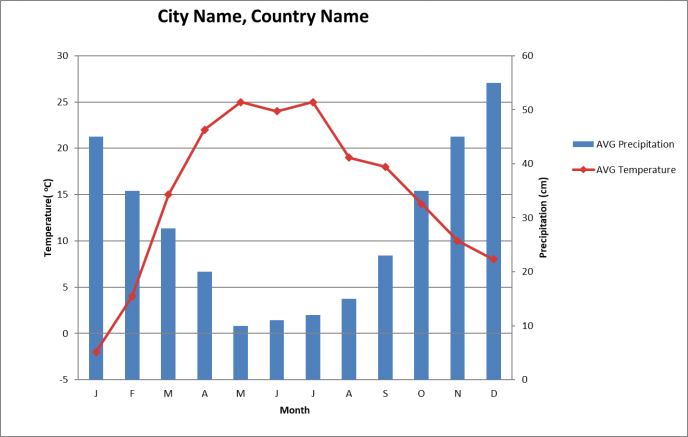GEO 110: The Physical Environment – Fall 2023
Hello, dear friend, you can consult us at any time if you have any questions, add WeChat: daixieit
GEO 110: The Physical Environment - Fall 2023
TERM ASSIGNMENT: Environmental Analysis (worth 25% of your final course grade)
MADE AVAILABLE: Sept 28, 2023 at 10:10am
DUE: October 27, 2023 by 12:00pm (i.e. the end of the lecture/tutorial period) via D2L
Climagraphs are utilized to depict annual cycles of temperature and precipitation derived from data averaged over many years (Strahler and Archibold, 2008). They are discussed in many Physical Geography textbooks. Check the Toronto Metropolitan University Library if you require further information.
A climagraph is a dual-purpose graph that shows two types of information. Precipitation is depicted using a bar graph, while a line graph shows the temperature conditions for the same place and time period. Climagraphs can be used to examine the climate of a place, which could be important (among other things) if a person was considering relocation to that particular place.
To begin the assignment, you should look for some sources that describe climate trends for specific cities. This may help you in identifying cities for downloading/acquiring data.
You can access this type of information in various journals. You MUST avoid using encyclopedias and/or their online counterparts for anything other than basic information searches.
You are required to prepare climagraphs for three cities/towns located outside of North America.
Go to https://worldweather.wmo.int/en/home.html to search for data for your chosen cities/towns. You need to obtain Mean Daily Maximum Temperature in °C and Mean Total Rainfall in cm. Note that the precipitation data may be provided in mm. Divide by 10 to obtain the values in cm.
You are required to enter these data into a spreadsheet in Microsoft Excel (which is available in university “drop-in” computer labs or can be downloaded/installed on your own computer from the university website) and produce aclimagraph for each city. The data MUST be entered as per the Data Table example below:
|
Month |
AVG Temperature |
AVG Precipitation |
|
J |
-2 |
45 |
|
F |
4 |
35 |
|
M |
15 |
28 |
|
A |
22 |
20 |
|
M |
25 |
10 |
|
J |
24 |
11 |
|
J |
25 |
12 |
|
A |
19 |
15 |
|
S |
18 |
23 |
|
O |
14 |
35 |
|
N |
10 |
45 |
|
D |
8 |
55 |
The climagraphs that you produce MUST have the same format as the example provided below.

An example file for data processing using Microsoft Excel has been made available for you on the course website. Go to:http://www.geography.ryerson.ca/wayne/Geo110-F2023/index.htm
Deliverables:
1) In 1200 (+/- 50, ~400 per city) words discuss the look of the climagraphs and the factors affecting the climate of each city/town. You can consider things such as: latitude, nearness to water, air masses, atmospheric and oceanic circulation, seasonality. In addition, compare and contrast the factors that account for the climate differences and/or similarities among the three cities/towns. References that are cited in your work MUST follow the example set in the Term Assignment Referencing document. You are also required to provide a Word Count in the top right corner on the title page of your submitted document.
2) In the final three pages of your submission, provide a copy of the data tables (as illustrated above) and your climagraphs for each of the cities on three separate pages (data table on the top of the page, corresponding climagraph below). Also supply the latitude and longitude coordinates of each of your cities.
3) Students are required to submit their assignments via D2L ina single Word .docx format. Do not submit pdf (or any other format) files as this will result in a grade of zero (0) for the term assignment.
Late penalty: 50% per day (not accepted if more than one (1) school day late unless a medical certificate is submitted or other acceptable arrangements have been made and confirmed in writing prior to the due date).
References:
Strahler, A.H. and O.W. Archibold. 2008. Physical Geography: Science and Systems of the Human Environment, Canadian, 4th Edition. New York: John Wiley and Sons Inc. 652pp.
2023-10-26